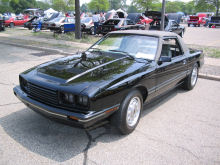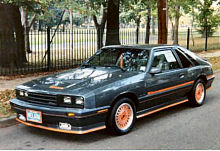It was apparent by 1984 that The Ford Motor Company, with their Mustang and Capri lines, had revived the American musclecar from certain demise. The GM offerings, Chevrolet Camaro and Pontiac Firebird, moved onward with overpriced and underpowered challengers and Chrysler's ponycars had long since departed. Foreign automobile manufacturers had jumped into the fray with what would be called 'pocket rockets'. These small, front wheel drive mini performance cars were giving the aged ponycars a run for their money. The big 3 car magazines noted that the VW's Rabbit GTI posted a quicker 0-60 time than the Z28 in '83. The Mustang and Capri, with their potent 5.0l V8 engines, solid bodies, excellent handling (for the time), and low price, were moving out of the showroom and on to the streets as fast as Ford could build them. It was natural for custom aftermarket builders and tuners to jump on the bandwagon.
 1984 marked the first year of the now well known, Saleen Mustang. Its success is now ledgendary in the Mustang's history. But another company also saw Ford's successful musclecar sales and embarked on creating one of the best Fox-bodied conversions ever built, the ASC/McLaren. The car was the brain-child of engineer Peter Muscat. He came up with the idea when his wife, a Ford employee, was not allowed park her Mercedes SL in the parking lot. In '82, he converted a '80 coupe into a 2 seat convertible, complete with a canvas top that folded underneath a hard cover, hiding it completely out sight. After the car was complete, he showed the car to Ford. Because Ford was planning a topless Mustang for the 1983 model year, it was suggested that he talk to the people at Linclon-Mercury. Since the Capri sales had been sliding and was being left out when the Mustang went topless, Mercury was sold on the idea after a version based on the Capri was made.
1984 marked the first year of the now well known, Saleen Mustang. Its success is now ledgendary in the Mustang's history. But another company also saw Ford's successful musclecar sales and embarked on creating one of the best Fox-bodied conversions ever built, the ASC/McLaren. The car was the brain-child of engineer Peter Muscat. He came up with the idea when his wife, a Ford employee, was not allowed park her Mercedes SL in the parking lot. In '82, he converted a '80 coupe into a 2 seat convertible, complete with a canvas top that folded underneath a hard cover, hiding it completely out sight. After the car was complete, he showed the car to Ford. Because Ford was planning a topless Mustang for the 1983 model year, it was suggested that he talk to the people at Linclon-Mercury. Since the Capri sales had been sliding and was being left out when the Mustang went topless, Mercury was sold on the idea after a version based on the Capri was made.
 Muscat contracted American Sunroof Company to build the cars based on his original design. ASC is a subcontractor to many of the worlds auto manufacturers. The manufacturers frequently call upon ASC to create either one-offs or low volume convertibles for lines of cars the major companies don't want bear the expense of creating on their own. McLaren is well known in the racing arena for their expertise in engine and chassis building. Back in 1981, McLaren teamed with Ford to make an ultra low production (11) Mustang to showcase the then new body style. In 1983, ASC brought McLaren onboard to help create the unique automobile, providing spings, shocks, struts, and wheels. Since Capri was only available as a 3 door hatchback and not in a coupe like the Mustang from which it's own convertible is derived from, major modifications to the body were required.
Muscat contracted American Sunroof Company to build the cars based on his original design. ASC is a subcontractor to many of the worlds auto manufacturers. The manufacturers frequently call upon ASC to create either one-offs or low volume convertibles for lines of cars the major companies don't want bear the expense of creating on their own. McLaren is well known in the racing arena for their expertise in engine and chassis building. Back in 1981, McLaren teamed with Ford to make an ultra low production (11) Mustang to showcase the then new body style. In 1983, ASC brought McLaren onboard to help create the unique automobile, providing spings, shocks, struts, and wheels. Since Capri was only available as a 3 door hatchback and not in a coupe like the Mustang from which it's own convertible is derived from, major modifications to the body were required.
 Muscat and ASC designed the convertible to be a 2 seater with a manual top that complete folds under a hard cover like the Mercedes SL line of the day. It was a very distinct difference compared to the Mustang droptop. Unfortunately, most of the modifications were limited to cosmetics rather than performance, despite the McLaren name on the side. The first year of production, 1984, netted sales of 50 convertible and 10 hatchbacks. This was despite the fact that Mercury never wanted to be officially involved and wouldn't honor warranty repairs on any of the modifications made by ASC. The cars were promoted in the individual dealerships with posters, signs and special brochures. However, the cars met with sales resistance, mainly due to the $21,000 price tag (in'84 dollars). The then new Lincoln Mark VII was roughly the same price and it shared the showroom with the decked out Capri.
Muscat and ASC designed the convertible to be a 2 seater with a manual top that complete folds under a hard cover like the Mercedes SL line of the day. It was a very distinct difference compared to the Mustang droptop. Unfortunately, most of the modifications were limited to cosmetics rather than performance, despite the McLaren name on the side. The first year of production, 1984, netted sales of 50 convertible and 10 hatchbacks. This was despite the fact that Mercury never wanted to be officially involved and wouldn't honor warranty repairs on any of the modifications made by ASC. The cars were promoted in the individual dealerships with posters, signs and special brochures. However, the cars met with sales resistance, mainly due to the $21,000 price tag (in'84 dollars). The then new Lincoln Mark VII was roughly the same price and it shared the showroom with the decked out Capri.
 1985 saw an increase in sales to 407 (150 H/B, 257 conv) units for the Capri. ASC took a greater step forward as it began to offer a supersport suspension kit containing stiffer springs that lowered that car and revalved struts. The interior was treated with real Recaro seats, leather wrapped steering wheel, and a 140-mph speedometer. A new front airdam, side body ground effects, and a rear valance filled out the exterior changes. Ford, by specifying a special DSO code for all ASC destined cars (D32), shipped these cars from the factory with the Motorsport B303 camshaft and Thunderbird Turbo Coupe tie-rod ends. This was to insure a factory warranty covered these parts
1985 saw an increase in sales to 407 (150 H/B, 257 conv) units for the Capri. ASC took a greater step forward as it began to offer a supersport suspension kit containing stiffer springs that lowered that car and revalved struts. The interior was treated with real Recaro seats, leather wrapped steering wheel, and a 140-mph speedometer. A new front airdam, side body ground effects, and a rear valance filled out the exterior changes. Ford, by specifying a special DSO code for all ASC destined cars (D32), shipped these cars from the factory with the Motorsport B303 camshaft and Thunderbird Turbo Coupe tie-rod ends. This was to insure a factory warranty covered these parts
 The next year was a turning point for ASC. It was the first year for the SEFI engine that replaced the driveability problems of the carburetion and CFI. It was also the last year of the Capri, which also meant it would be that last year of the ASC/McLaren built on the Capri. The 1986 models were essentially unchanged from the previous year. Bowing to dealer pressure to reduce the price of the cars, ASC offered a 'stripped down' version called the Eurocoupe. Based on the hatchback, the car was devoid of the accent stripes, high end stereo, radar detector, and a few other niceties. Sales rose for the final year to 407 cars, 245 convertibles, 115 hatchbacks, and 47 Eurocoupes. Although the 3-door model captured more than a third of the sales, this was the last year it was offered.
The next year was a turning point for ASC. It was the first year for the SEFI engine that replaced the driveability problems of the carburetion and CFI. It was also the last year of the Capri, which also meant it would be that last year of the ASC/McLaren built on the Capri. The 1986 models were essentially unchanged from the previous year. Bowing to dealer pressure to reduce the price of the cars, ASC offered a 'stripped down' version called the Eurocoupe. Based on the hatchback, the car was devoid of the accent stripes, high end stereo, radar detector, and a few other niceties. Sales rose for the final year to 407 cars, 245 convertibles, 115 hatchbacks, and 47 Eurocoupes. Although the 3-door model captured more than a third of the sales, this was the last year it was offered.
The best years of ASC/McLaren were about to begin. CONTINUE ...



